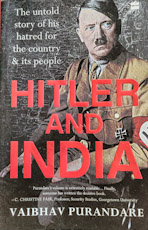
The popularity of vegetarianism and its relative veganism has greatly increased in the western world in recent years, and is still increasing. Popular reasons for abandoning the consumption of meat and/or products derived from animals (e.g. milk and eggs) include seemingly virtuous reasons such as love of animals and a desire to protect the world’s climate.
On the 23rd of July 1939, one world-famous vegetarian wrote a letter to another equally well-known vegetarian. Mahatma Gandhi wrote to Adolf Hitler. Here it is in a much abbreviated form (from: https://www.mkgandhi.org/letters/hitler_ltr1.htm):
“DEAR FRIEND,
That I address you as a friend is no formality. I own no foes.
… We have no doubt about your bravery or devotion to your fatherland, nor do we believe that you are the monster described by your opponents. But your own writings and pronouncements and those of your friends and admirers leave no room for doubt that many of your acts are monstrous and unbecoming of human dignity, especially in the estimation of men like me who believe in universal friendliness
… I, therefore, appeal to you in the name of humanity to stop the war. You will lose nothing by referring all the matters of dispute between you and Great Britain to an international tribunal of your joint choice
…You know that not long ago I made an appeal to every Briton to accept my method of non-violent resistance.
… During this season when the hearts of the peoples of Europe yearn for peace, we have suspended even our own peaceful struggle. Is it too much to ask you to make an effort for peace during a time which may mean nothing to you personally but which must mean much to the millions of Europeans whose dumb cry for peace I hear, for my ears are attended to hearing the dumb millions? …
I am,
Your sincere friend,
M. K. GANDHI“
The letter never reached Hitler; it was intercepted by the British in India.
I have no idea what the monster Adolf Hitler had to say about vegetarianism, but the saintly and peace-loving Gandhi wrote much about his abstinence from meat. For example, in 1932 he wrote:
“I do feel that spiritual progress does demand at some stage that we should cease to
kill our fellow creatures for the satisfaction of our bodily wants. The beautiful lines
of Goldsmith occurs to me as I tell you of my vegetarian fad:
‘No flocks that range the valley free
To slaughter I condemn;
Taught by the Power that pities me
I learn to pity them’ “
(see: https://www.mkgandhi.org/ebks/moralbasis_vegetarianism.pdf)
And at another time:
““It is very significant that some of the most thoughtful and cultured men are partisans of a pure vegetable diet.”“.
Maybe, he was thinking of the man of culture, Bernard Shaw, rather than Adolf Hitler!
Returning to the present day and the increasing appetite for meatless and dairy-free food, let us consider the current desire for vegetarian products to resemble meat products. Supermarket shelves are filling up with veggie burgers, meatless steaks, meatless meat balls, meatless shawarma, and many other products made to resemble meat without containing it. Recently, I was in a Chinese restaurant, which offered diners vegetarian chicken and vegetarian duck dishes. This yearning for vegetarian products to be named like and to look like meat products is absurd,
There are plenty of delicious vegetarian dishes that are not made to resemble foods that usually contain meat. Middle-Eastern and Turkish cuisine, for example, offer vegetarian eaters delights such as: humous, fattoush, Imam Bayildi, Mutabbel (an aubergine dish), falaffel, stuffed peppers,etc. Even the French, who until recently have not been overly attracted to vegetarianism, have a traditional dish perfect for vegetarians: ratatouille. As for Indian cuisine, there is a plethora of dishes that are vegetarian and do not try to appear like meat. In India, the land where Gandhi was born, vegetarianism is a way of life, rather than a changed lifestyle, for hundreds of millions of people. This has been the case in India for many millennia.
To conclude, what I am trying to say is that if you wish to abandon eating meat for whatever reason, then you might as well abandon the desire to eat things that look like meat, but are not. If you are adopting vegetarianism, then enjoy meatless dishes for their own sake, not because they remind you of meat! Bon apetit!
Picture source: tesco.com










